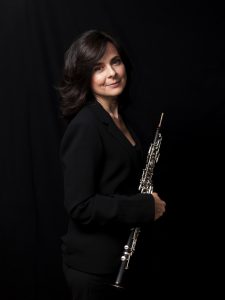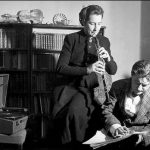Meeting Hélène Devilleneuve, oboe

Seing the instrumentalist at the concerts of the Court-circuit ensemble, and following a recital of presentation of her last CD, we met Hélène Devilleneuve for this fast and friendly interview.
Cursus
Born in Avignon, Hélène Devilleneuve came from parents teachers (Plastic arts and sciences) who gave her an artistic education; Arrived at Versailles at the age of 7, she began to play the recorder at the Conservatoire. Its director, the composer Jean Aubain (1928-2015) encouraging students to choose a second instrument that can be played in the orchestra, she chose the oboe, charmed by its solar sound. She studied with Michel Descarsin (1st solo oboe of the Colonnes concerts and of the Republican Guard), who encouraged her to pursue a career in music; she also had for teachers André Chevalet (Oboe at the Orchestre Philharmonique) and then Alain Denis (English Horn at the Orchestre de paris): “all these teachers were mutually esteemed.”
This was followed by the Conservatoire de Paris with Maurice Bourgue, David Walter and Jean-Louis Capezzali. She will be the winner of several competitions: Sony Competition in Tokyo or Barbiroll Competition, (from the name of the wife of the conductor John Barbirolli, who was the first oboist female soloist orchestra).
Admitted at the same time to the Orchestra of the Republican Guard, she chose the Royal Philharmonic Orchestra of Flanders from 1992 to 1995, before obtaining her current post: first super-solo oboe at the Orchestre Philharmonique de Radio France. When I asked her if the Conservatoire was preparing for the orchestra work: “quite: the professors all had the experience of the chair”. “The orchestra is now led by Mikko Franck, who is doing a great job with us. We are fortunate that the three successive musical directors have contributed enormously to the orchestra: Marek Janowski, Myung Whun Chung and now our new Finnish conductor.
Contemporary music
She joined the Ensemble Court-circuit in 1992. She was enraptured by an analysis of the Prélude à l’après-midi d’un faune made by Philippe Hurel, during a meeting at the Conservatory of Versailles. The first piece she will play by him will be “Pour l’image” with among other musicians the flutist Juliette Hurel (who is not related to the composer …). It is therefore quite natural that she accepted to be part of the ensemble at its creation by Philippe Hurel and Pierre-André Valade : «I love the momentum of creation, the exchanges with the creators, to see a work created and also the sensation of creating ‘new’, not having the weight of the historical versions of the works of the repertoire. ».
The Instrument
There are, in fact, four major types of instruments called “oboes”: the oboe itself, the oboe d’amour, which is found, for example, in Gigues de Debussy or Ravel’s Boléro, the English horn, and more rarely the baritone oboe.
For oboe makers, most of the oboes are French (Rigoutat, Marigaux, Lorée and Buffet-Crampon, among others). If there are of course other manufacturers in Italy, Germany or Japan, for example, 80% of the oboes played in the USA are by Lorée, probably because of the influence of the famous oboist Marcel Tabuteau who was for nearly thirty years Professor at the Curtis Institute of Music in Philadelphia.
She also practices the baroque oboe in time lost, she appreciates the spun sounds, close to the flute, for the sake of authenticity of style and mode of play for this repertoire …
Répertoire
Main oboe concertos are by Bach, Vivaldi, Mozart, R. Strauss, Vaughan Williams, Martinu, Ibert, the four by Maderna and the double by Ligeti…
Some works have been dedicated to her (Trame by Matalon, Interlude by Dalbavie). She has played « tous les spectrauxall the spectral composers and particularly appreciates the music of Gérard Grisey, Michael Jarrell, Asbjorn Schaatun, Alexandro Markeas, Frédéric Durieux, Ivan Fedele, Tristan Murail. She hopes that a piece for oboe and orchestra by a composer who has been quoted will soon be created … “I love composers who have renewed their language”.
Teaching
“This is the third foot of my balance with solo and orchestral activities. I love teaching: it’s a real introspection.” In addition to her oboe teaching activities, she is also a professor of visual reading at the CNSM for “woods” (flute, oboe, clarinet, bassoon and saxophone): “but it is very useful for musicians, especially in the orchestra, to be able to quickly decipher the scores, and to adapt as quickly as possible to a particular musical style or configuration”. On the general level of instrumentalists: “There have always been meteors like Maurice Bourgue, Heinz Holliger, François Leleux who is a model for everyone, or more recently Philippe Tondre, but the general level is rising, along with envy and curiosity, from baroque music to contemporary music. I plan to invest more and more in education”.
Projects
“I was invited with other orchestral soloists from all over the world to play Mahler’s 7th with the New York Philharmonic and Alan Gilbert, a conductor I particularly like. It will be in 15 days as part of a UN program. ”
« Finally, I am thinking about a project of two new CDs, after the recent release of my CD devoted to French music for oboe and piano, at Klarthe last April: one devoted to the contemporary oboe and probably a disc of romantic music ».

